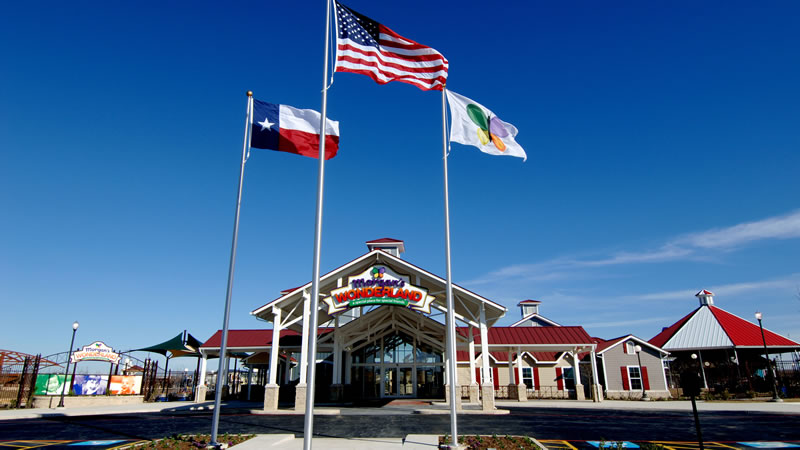The Magical Place Where Everyone Can Play

Kids love the beach, swimming pools, water parks, playgrounds, and amusement parks. But for some, the promise of fun isn’t one fulfilled by the actual experience. For children who have special needs, the experience can often be frustrating. Most of the attractions are not built with these children in mind, and when accessibility concerns are considered, they are often done in clunky, obvious ways. Children who struggle with sensory inputs may be overwhelmed. Those who have difficulties communicating or processing information may require more oversight than conditions allow. And perhaps worst of all, the other children often don’t want to play with those who need more help. What should be a magical experience for children and their families instead becomes a difficult one.
About twenty years ago, a Texas man named Gordon Hartman saw this first hand. While on a family vacation, his daughter Morgan went into a hotel swimming pool. Morgan, who has autism as well as some significant physical limitations, was playing in her own way and, per her dad’s account, having a good time. Some other children were playing at the other end of the pool, throwing a ball around. But when Morgan slowly made her way across the pool in hopes of playing with them, they left.
Gordan decided to do something about it.
For most of his adult life, Gordan Hartman was a home builder and a successful one at that. In 2005, the new home construction was in a boom, and he had the opportunity to sell his business to a larger one — as he would later say, it was a deal that gave him enough money to comfortably retire just after his 40th birthday. After selling the business, he had plenty of money and free time on his hands and wasn’t sure what to do next. But that day in the hotel pool had inspired him to find a solution.
Or, rather, to build one. As the BBC reported, using some of the proceeds from the sold business, he “set up The Gordon Hartman Family Foundation, a non-profit organization that seeks to help people with disabilities. Then he set about creating the ‘world’s first ultra-accessible theme park.'” Hartman told the BBC that the vision was simple but grand: “we wanted a theme park where everyone could do everything, where people with and without special needs could play.”
After building a team of “doctors, therapists, parents and other people with and without disabilities to consult on the facilities,” Hartman got to fundraising (he put in $1 million himself) and then building. The process kicked off in 2007 and in 2010, the new theme park, called “Morgan’s Wonderland,” opened on a 25-acre site near San Antonio. Per the BBC, “attractions include a fully-accessible Ferris wheel, adventure playground, and miniature train,” as well as “a carousel with specially designed chariots for wheelchairs that go up and down alongside the animals.” Even the spaces between the attractions are designed differently; as ABC News reported, pathways are wider than usual and stairs are infrequently used, all to make wheelchair users and others not have to think twice about what they can and cannot access. And all visitors are given a wristband with an RFID tag; as Hartman explained in his TEDx talk, the Wonderland team wanted to caretakers additional peace of mind in case a child was separated from the rest of his or her family.
But the design goes beyond accessibility. Inclusion is just as important. Morgan’s Wonderland is designed to be as close to a typical amusement park as possible so that those with specific needs can participate fully, and do so alongside those who do not need an accommodation. As FreeThink reported, “Gordon Hartman will emphasize again and again – this is not an amusement park for kids with special needs. This is an amusement park for everyone.” For example, rides do not have separate entries for those who can walk and those who can’t; all visitors use the same entrances wherever possible.
And the cost? Guests with special needs are given free admission to the park. As Hartman says, the staff at Morgan’s Wonderland simply asks if you have special needs; if you say you do, there’s no charge. (“If you lie about it,” Hartman deadpans in his TEDx talk, “we figure you have a special need.”) The park runs at a loss each year, but fundraising makes up for the difference — and has allowed for some major expansion. In July of 2017, the Wonderland opened a waterpark, complete with waterproof motorized wheelchairs that visitors can borrow as needed.
As of 2017, more than a million guests visited Morgan’s Wonderland — and hopefully, millions more will also get a chance to experience it in the years to come.
Bonus fact: It makes sense that a builder would want to build an amusement park — but why not just turn homebuilding into that same-ish experience? That’s what an English entrepreneur named Hugh Edeleanu cooked up about fifteen years ago. He opened a theme park called “Diggerland” where visitors can operate heavy machinery (in a controlled, supervised way, of course). It sounds niche, but it’s proven successful: there are multiple locations in England and one in New Jersey (which I’ve actually visited and yes, it’s surprisingly a lot of fun).
From the Archives: Wonderland, On Ice: The theme park that never quite made it — but also didn’t go away.
